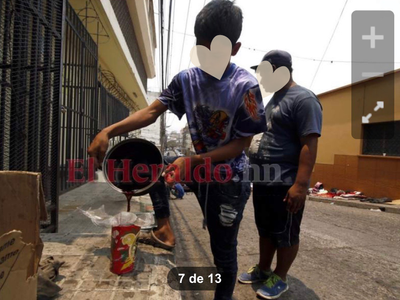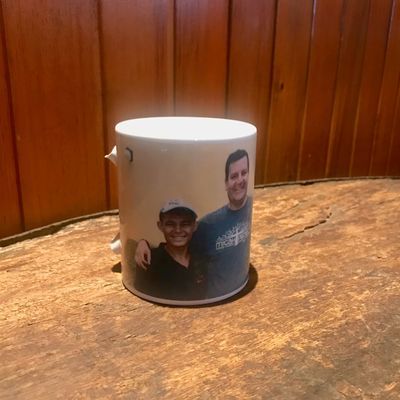God dwells under the bridge.

My heart caught in my throat last week when I was flipping through a Honduran newspaper and came across a picture of one of our boys. Alejandro is a kid that I love fiercely—a life that Micah has fought to save. His sixteen years have been a constant battle, struggling to get beyond the streets, only to fall back into drugs over and over again. We have shed blood, sweat and tears over this kid, who so often seems to choose to live in that in-between-space between life and death.
In the newspaper article, Alejandro is backlit; his shadowed form is pouring thick black coffee into a makeshift filter. An organization has donated primitive gas stoves to the street kids, and he is using it to make coffee to pass out to his friends. He is totally focused on this task; I’m not even sure that he knows his picture has been taken. The newspaper’s caption reads, “a street-connected youth prepares coffee on a sidewalk where he also sleeps.”
It is surreal to see his picture in the newspaper, to see this grainy, two-dimensional photo of a child who is such an important part of my life. I flash back to one of the many times that Alejandro came back to Micah from the streets. We had brought him to the couch in my cabin to give time for the yellow glue fumes to dissipate. He fell asleep and, hours later, I was unable to rouse him. I picked him up and managed to carry him down the stairs of my cabin, across the sidewalk and into the Micah House. I laid him down on his bed that had been empty since he left to the streets several weeks before. He wouldn’t wake up until mid-morning the next day, bleary but ready to start again.
And now, here he is in black-and-white, back on the streets, making coffee for his friends. The reason Alejandro’s picture is in the paper, though, is not because there is a sixteen-year-old living on the streets. That’s not news in Honduras. In fact, we have visited nine or ten street kids on this corner for years. We call it the “Loco Luis” corner because of the store that’s been here for years—Crazy Louie’s—that sells all sorts of used items, from grungy couches to outdated TVs to new-to-me motorcycles. We know the names of every kid on this corner. Most often, they are ignored by the rest of the world, part of the scenery in this city where poverty is just a fact of life.
The only other time I can remember this forgotten group of kids making the news was when a nineteen-year-old street girl had her baby right here on the corner. The cameras pulled up in time to catch her screaming and in agony, fighting the paramedics trying to get her into the ambulance. A few days later, Micah’s social worker helped to place her baby in a caring home, and she went back to Crazy Louie’s corner, forgotten once again by the world around her.
A couple of days after Alejandro’s debut in a local paper, Crazy Louie’s corner made the international press. Reuters and the New York Times published articles referring to it. But this has very little to do with Joel and David and Alejandro and Joselyn and the other kids that have survived for years on this corner. On March 15, Honduras shut down its economy completely in order to prevent the spread of COVID-19. They closed all businesses, shut down public transportation and blocked all roads. The government even suspended constitutional guarantees and made it illegal to be out in public except on certain days. In a country where a majority of people live day-to-day, families immediately started to go hungry. A couple of weeks into the shutdown, many families began to lose their homes as well, unable to make enough money to pay rent. The numbers of homeless people on Crazy Louie’s corner began to swell. Our nine kids blossomed to fifteen, then twenty-five, then forty. Whole families—including newborn babies—began to appear on this corner, lining up their belongings on the sidewalks on both sides of the street. (Read the Reuters’ article here).
That is when the world began to take notice. In the last couple of weeks, Crazy Louie’s corner has come to symbolize the impact that a pandemic has on a developing country like Honduras. High-quality news organizations don’t just publish statistics; they look for heart-wrenching stories accompanied by powerful images that will bring those statistics to life. The families that have come to live on this nondescript corner of downtown Tegucigalpa have been chosen to represent the suffering that COVID-19 has brought down upon the world’s most vulnerable people.
That’s good though, right? More publicity means more help! We saw that back when Hurricane Mitch destroyed Honduras in 1998—millions of dollars of relief and aid flowed into the country. Indeed, a flood of desperate people have come to our gates asking for our help every day since the quarantine began. We have bought hundreds of pounds of beans and rice, packets of spaghetti and dried milk, and have tried to give it to as many hungry people as we can. Thankfully, we’ve also had other organizations, churches and individuals here in Honduras give us food and other supplies to help those that are suffering. And, now, when we go to visit the street youth and families on Crazy Louie’s corner, we often encounter other generous people there, lending a helping hand. It’s a beautiful thing to see the world come together to help the most vulnerable.
And yet, I am wary. Even as the Micah Project has begun to reach out for extra funds to help these suddenly-homeless families, I fret about the risk that turning our friends into an international cause will unintentionally strip them of their humanity. A kid that I have laughed and cried with, a kid that I have played soccer with, a kid who has sat next to me at my desk drawing pictures while I complete my office work—this is a kid who has suddenly become an archetype for pandemic-induced suffering. Alejandro’s picture is now a stock image that will come up when someone searches for “how the pandemic victimizes the poorest of the poor.”
Christian missions have rightly come under criticism in the past for being too paternalistic. We have been guilty of painting a picture of the heroic American church going to the ends of the earth to save the poor, helpless, ignorant natives. Too often, our missionary stories are about them needing what we have to give, blank slates ready to be blessed by our largesse. Now that my Facebook wall is suddenly flooded with images of generous Christians handing out food (including some that I have posted myself!) I fear that we are telling an outdated story once again.
An author I read recently says this: “God is in every place of poverty, degradation, oppression and anguish, long before helpful outsiders arrive.” I wonder if we come closer to the gospel message when we accept this truth as a starting point.
I was down on Crazy Louie’s corner one evening a couple of years ago talking with some of the kids. A long-time street youth name Brayan came bounding over to me, a huge smile on his face. “Michael, I have something for you!” He produced a mug on which was printed a picture of him and me smiling, arms over each other’s shoulder. The fact that he had accidentally broken the handle off the mug didn’t diminish his joy in giving it to me. “Brayan, how did you get our picture printed on a mug?” I was shocked. He gleefully launched into an explanation about a friend of his who has a printing business who gave him a deal on the mug.

At that moment, Brayan’s broken mug was gospel love in action. His gift encouraged my heart that day and brings a smile to my face every time I pull it out of my cupboard. He owns no earthly possessions, but he modeled God’s love to me through his gift and through the joy he took in giving it. Does Brayan have a complete grasp of the gospel message? Perhaps not. He definitely has his share of demons that keep him forever teetering on the edge of a cliff. But, over and over again in the gospels, Jesus saw beyond the demons to the child of God hidden behind them. He saw the potential for love that each of them had; hence, his instructions to the demon-possessed man of the Gerasenes to “go and tell them how much the Lord has done for you” (Mark 5:19). Jesus doesn’t see the man as a passive receiver of his love; he empowers him to spread that love far and wide.
One of the most degraded sections of Tegucigalpa is an area of dry river bed next to the river that separates the more formal business and government district from the chaotic, cacophonous mass of humanity that is the outdoor market. All the refuse from the market gets dumped on this dry ground by the river that slices Tegucigalpa down the middle, from rotting, unsold fruit and vegetables to the bones and other animal viscera from the dozens of butchers that line the market streets.
Before the gangs drove them out, we used to visit a group of street kids and homeless families that lived under the bridge that soared above this putrid place. They lived among the trash that was strewn everywhere, and they had a pile of meager belongings stacked up against one of the arches of the bridge. Stray dogs, pigs and the occasional cow wandered among the piles of trash, in competition with dirt-streaked kids picking through the trash in search of the day’s lunch. There was always a little kid that stuck out in my memory, a toddler named Edwin who was always covered head to toe in grime and sitting on a dirty piece of sponge mattress. Whenever we took visitors to visit this group, this little kid would almost always drive them to tears.

Does God even know this place exists? More than once, the thought ran through my mind that this place is a physical manifestation of hell, humans living amidst the decay, seemingly abandoned by God.
I noticed on a visit to the bridge that one of our homeless friends had taped something to the leg of the bridge, just above their pile of belongings. It was a poster-sized print of da Vinci’s The Last Supper. There was Jesus, arms stretched wide, looking down upon those who made their homes in this awful place.
Ever since, that picture has been a gentle rebuke and a constant reminder. I only wanted to see the trash, to smell the decay, to see the dirt on the child’s face, in order to judge this place as godless. Surely, the only way God will arrive at this place is if I am the one to bring his Good News? But one of his homeless children taped that picture to the bridge as if to say, “Of course God is here! We are his children and we are here, right? Didn’t he promise never to leave or forsake us?”

Many years later, the people we used to visit under that bridge are long gone, as is the da Vinci print, washed away by one too many flash floods. That print remains in my memory as a constant reminder, though. It challenges me to avoid seeing the homeless youth only as victims, as snapshots printed in the newspapers that only tell a story of helpless despair. God was under that bridge long before we ever started visiting there. He was on Crazy Louie’s street corner years before COVID-19 and quarantines began to drive more people out of their homes. If we are to believe his word, then we must believe that even those who are forced to make their bed in depths will find Him there with them. According to the Psalmist, He will go to sheol itself to search them out. Alejandro and Brayan and Nicole? He’s been at work in their lives ever since he knit them together in their mothers’ wombs.
Of course, we can help them to see Him and His presence more clearly, even in the midst of their brokenness. We are called to become a part of their lives, to reach out with His love, even to provide for their physical needs. But our ability to do that does not make us better than them, or somehow worthier to be his children.
The next time you see those pictures of people suffering on Crazy Louie’s street corner, avoid the temptation to interpret their entire existence through the caption under their picture: “poor people victimized by the quarantine.” Choose to see them as brothers and sisters, to see them through our Father’s eyes, children beloved by Him and also capable of great love.
Don’t just see the sheol in them. Gaze upon His handiwork in them as well. And don’t be surprised when one of them hands you a broken mug as an undeserved gift—a pearl of great price—and becomes a bearer of His gospel love to your own broken soul as well.
Michael Miller - May 2020

